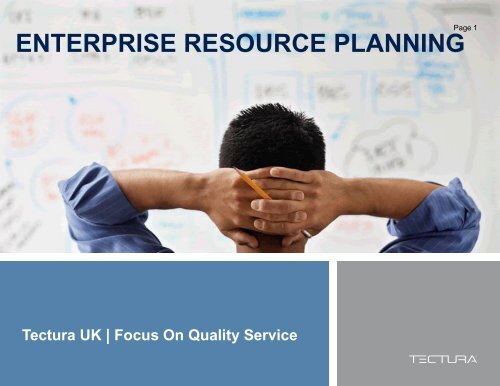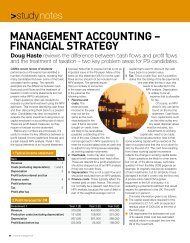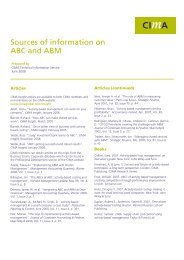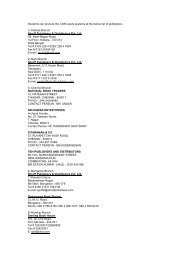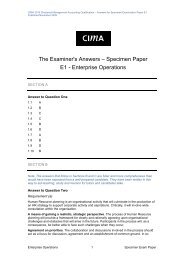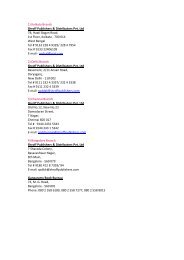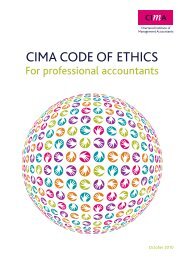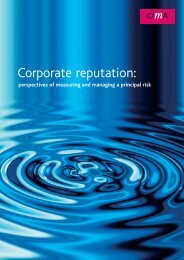ENTERPRISE RESOURCE PLANNING - CIMA
ENTERPRISE RESOURCE PLANNING - CIMA
ENTERPRISE RESOURCE PLANNING - CIMA
You also want an ePaper? Increase the reach of your titles
YUMPU automatically turns print PDFs into web optimized ePapers that Google loves.
Page 1<br />
<strong>ENTERPRISE</strong> <strong>RESOURCE</strong> <strong>PLANNING</strong><br />
Tectura UK | Focus On Quality Service
Enterprise Resource Planning<br />
Agenda<br />
• Introduction<br />
• What is ERP?<br />
• Benefits of implementing ERP<br />
• Success factors and related pitfalls<br />
• Questions and answers<br />
Page 2
Enterprise Resource Planning<br />
Introduction<br />
• Presentation given by:<br />
• Andy.Blatch@Tectura.com<br />
Page 3
Enterprise Resource Planning<br />
What is ERP? - Definition<br />
• Enterprise resource planning (ERP) is an integrated computerbased<br />
system used to manage internal and external resources<br />
including tangible assets, financial resources, materials, and<br />
human resources.<br />
• It is a software architecture whose purpose is to facilitate the flow<br />
of information between all business functions inside the<br />
boundaries of the organization and manage the connections to<br />
outside stakeholders.<br />
• ERP systems consolidate all business operations into a uniform<br />
and enterprise wide system environment.<br />
Page 4
Enterprise Resource Planning<br />
What is ERP? - Historical perspective<br />
• Disparate systems<br />
• Materials Requirements Planning (MRP)<br />
• Manufacturing Resource Planning (MRP II)<br />
• Enterprise Resource Planning (ERP)<br />
Page 5
Enterprise Resource Planning<br />
What is ERP? – Functional perspective<br />
• Financials<br />
• Distribution<br />
• Supply Chain Management<br />
• Manufacturing<br />
• Human Resources<br />
• Customer Relationship Management<br />
• Project Management<br />
Page 6
Enterprise Resource Planning<br />
What is ERP? – General traits<br />
• Integrated (no need for IS intervention)<br />
• Real time (no periodic batch updates)<br />
• Same look and feel throughout<br />
• Single data definitions<br />
• Security permissions<br />
Page 7
Enterprise Resource Planning<br />
What is ERP? – Advanced traits<br />
• Multi country (including multi-lingual and multi-currency)<br />
• Out of the box integration with standard tools (Excel, etc)<br />
• IFRS, Sarbanes-Oxley, Basel II compliant<br />
• “Best practices” included<br />
• Role based<br />
Page 8
Enterprise Resource Planning<br />
What is ERP? – Vendors<br />
Page 9
Enterprise Resource Planning<br />
What is ERP? – Structure<br />
• Core<br />
• Localisation<br />
• Industry solution<br />
• Customisation<br />
• Configuration<br />
Page 10
Enterprise Resource Planning<br />
What is ERP? – The future<br />
• Software as a service<br />
• Web enabled self service<br />
• Improved BI<br />
• Industry specific functionality<br />
• Role based<br />
Page 11
Enterprise Resource Planning<br />
Advantages of ERP – General objectives<br />
• Replace legacy systems<br />
• Improved information flow<br />
• Enable business growth<br />
• Standardised working practices<br />
• Reduced costs<br />
• Faster response times<br />
• Single data entry<br />
• Reduce reliance on individuals<br />
Page 12
Enterprise Resource Planning<br />
Advantages of ERP – Tangible benefits 1<br />
• Reduction in stock levels due to improved planning<br />
• Monthly accounts closing in fewer days<br />
• Improved financial accuracy and financial efficiency<br />
• Meaningful reports<br />
• One version of the truth<br />
• Improved visibility and access to information<br />
Page 13
Enterprise Resource Planning<br />
Advantages of ERP – Tangible benefits 2<br />
• Improved financial control<br />
• Reduction in staff due to automation of tasks<br />
• Cost saving through shared services<br />
• Reduction in cost of maintaining multiple systems<br />
• More time for managing the business<br />
Page 14
Page 15<br />
Enterprise Resource Planning<br />
Advantages of ERP – Management Accounting perspective 1<br />
• Reduction in time spent on data collection<br />
• Increase in time spent on data analysis<br />
• Increased involvement in decision making<br />
• Improved focus on internal reporting<br />
• Improved focus on external environment
Page 16<br />
Enterprise Resource Planning<br />
Advantages of ERP – Management Accounting perspective 2<br />
• Shift in focus from historical to forward looking analysis<br />
• Shift from domain specific to cross-functional analysis<br />
• Changes required in communication skills<br />
• Improved long term job satisfaction
Enterprise Resource Planning<br />
10 Critical Success Factors – 1<br />
• Executive sponsorship<br />
Once an implementation is undertaken it must be at least the second<br />
highest priority of the business after the normal functioning of the<br />
business.<br />
The project must be business driven not IT driven.<br />
The sponsor is responsible for setting goals and communicating the<br />
corporate IT strategy to all employees.<br />
Page 17
Enterprise Resource Planning<br />
10 Critical Success Factors – 2<br />
• Project management<br />
Plan and control (including change control) the project scope to meet the<br />
deliverables within the given time and budget<br />
Issue and risk management<br />
Facilitate change management (the implementation is as much about<br />
business change as it is about technology change)<br />
Page 18
Enterprise Resource Planning<br />
10 Critical Success Factors – 3<br />
• Solution selection<br />
Degree of solution fit to your business processes and future needs<br />
Due diligence of software supplier and consulting partner<br />
Total Cost of Ownership – elements include:<br />
• Licence cost per user<br />
• Degree of customisation and ease of customisation<br />
• Consulting rates<br />
• Ease of adoption<br />
• On-going support<br />
Page 19
Enterprise Resource Planning<br />
10 Critical Success Factors – 4<br />
• Clear goals and objectives<br />
Set prior to seeking executive sponsorship<br />
Reference these throughout the life cycle<br />
Communicate appropriately to project team<br />
Ensure other business initiatives do not conflict<br />
Page 20
Enterprise Resource Planning<br />
10 Critical Success Factors – 5<br />
• User education<br />
Do not underestimate the importance of training<br />
Training may be wider than just the ERP system<br />
Train the core team early<br />
Continue training/familiarisation throughout the implementation<br />
Plan for training needs after the go-live<br />
Provide training in multiple media<br />
Use subject matter experts to provide key training<br />
Page 21
Enterprise Resource Planning<br />
10 Critical Success Factors – 6<br />
• Business Process Re-engineering<br />
Review prior to implementing the ERP solution<br />
Deficiencies in current system and processes<br />
Strengths of current system and processes<br />
Business critical processes<br />
Competitive advantage<br />
Increase productivity through organisation restructuring<br />
Page 22
Enterprise Resource Planning<br />
10 Critical Success Factors – 7<br />
• Dedicated project team<br />
Plan individual commitment required<br />
Recognise other business events that may be constraints<br />
Detailed business knowledge<br />
Backfill where appropriate<br />
Plan an individual exit strategy<br />
Page 23
Enterprise Resource Planning<br />
10 Critical Success Factors – 8<br />
• Project team competency<br />
Knowledge, skills, abilities and experience<br />
Relevant business experience<br />
Support of the wider business community<br />
Page 24
Enterprise Resource Planning<br />
10 Critical Success Factors – 9<br />
• Vendor support<br />
Software vendor support<br />
Implementation partner support<br />
Hot fixes, service packs and version upgrades<br />
Global or local<br />
Technical reviews<br />
Performance reviews<br />
Health checks<br />
Page 25
Enterprise Resource Planning<br />
10 Critical Success Factors – 10<br />
• Communication<br />
Interdepartmental<br />
Realistic<br />
Celebrate successes<br />
Page 26
Enterprise Resource Planning<br />
Questions and answers<br />
• Please feel free to ask any questions<br />
Page 27
www.tectura.co.uk<br />
CLICK TO EDIT MASTER SUBTITLE STYLE<br />
Page 28


